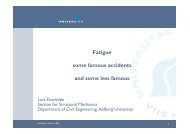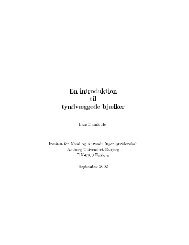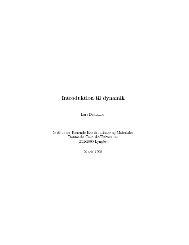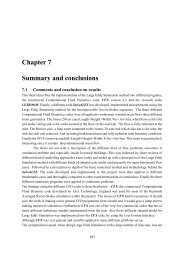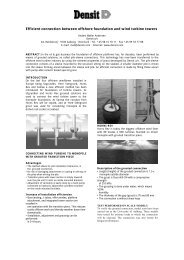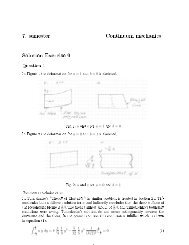Benchmark Test for a Computer Simulated Person - Aalborg ...
Benchmark Test for a Computer Simulated Person - Aalborg ...
Benchmark Test for a Computer Simulated Person - Aalborg ...
You also want an ePaper? Increase the reach of your titles
YUMPU automatically turns print PDFs into web optimized ePapers that Google loves.
Version of February 2007<br />
<strong>Benchmark</strong> <strong>Test</strong>s <strong>for</strong> a <strong>Computer</strong> <strong>Simulated</strong> <strong>Person</strong><br />
- Manikin Heat Loss <strong>for</strong> Thermal Com<strong>for</strong>t Evaluation<br />
Introduction<br />
Håkan O. Nilsson, Henrik Brohus and Peter V. Nielsen.<br />
Version of February 2007<br />
Researchers around the world have developed many different configurations in order to represent<br />
a computer simulated person (CSP) or a virtual CFD manikin. These manikins are different with<br />
respect to size, <strong>for</strong>m, heat generation, turbulence models and computer codes used, etc. The<br />
variations reflects the various possibilities and limitations in software as well as different subjects<br />
of interest as manikin effects on the airflow, thermal com<strong>for</strong>t as well as pollutant production and<br />
exposure. The levels of detail are also of great interest as well as recommendations on how and<br />
when to simplify the CSP. This evolution can be shown with the following examples:<br />
<strong>Simulated</strong> Occupant Computational Thermal Manikin Berkeley Com<strong>for</strong>t Model<br />
Gan (1994) Murakami et. al. (1997) Huizenga et. al. (2001)<br />
Nielsen et. al. (2003) introduced two benchmark tests focusing on the airflow around virtual<br />
thermal manikins or CSPs. The new benchmark test described here will focus on the different<br />
heat losses from the manikin with the aim to predict how humans will react to different climatic<br />
situations and is developed in cooperation between <strong>Aalborg</strong> University and the University of<br />
Gävle, Sweden. The earlier mixing ventilation benchmark test has been developed by <strong>Aalborg</strong><br />
University within the framework of the International Centre <strong>for</strong> Indoor Environment and Energy,<br />
and the displacement ventilation case has been developed at the University of Tokyo and Keio<br />
University.<br />
This paper introduces a benchmark test <strong>for</strong> a CFD manikin or a CSP. This test is evaluated in full<br />
scale to get measurements <strong>for</strong> comparison with CFD predictions. The idea behind a CFD manikin<br />
benchmark test, which define the boundary conditions around a real as well as CFD manikin,<br />
have the following reasons: If different versions of virtual CFD manikins can be tested with the<br />
same boundary conditions, it is possible to make comparisons, and perhaps make some new<br />
decisions on geometrical level of details of the design, turbulence model used, type of grid etc.<br />
This will hopefully lead to a more focused development of a simplified, comparable, easy to use<br />
Page 2 of 7




